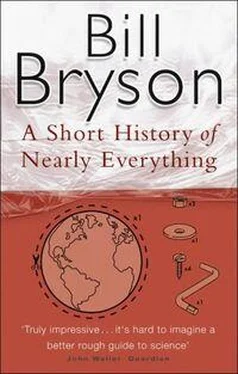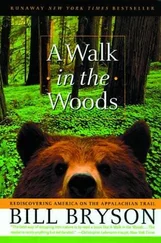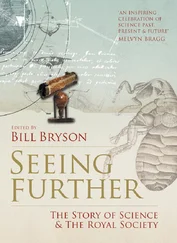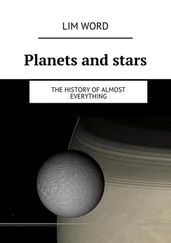The average species on Earth lasts for only about four million years, so if you wish to be around for billions of years, you must be as fickle as the atoms that made you. You must be prepared to change everything about yourself-shape, size, color, species affiliation, everything-and to do so repeatedly. That’s much easier said than done, because the process of change is random. To get from “protoplasmal primordial atomic globule” (as the Gilbert and Sullivan song put it) to sentient upright modern human has required you to mutate new traits over and over in a precisely timely manner for an exceedingly long while. So at various periods over the last 3.8 billion years you have abhorred oxygen and then doted on it, grown fins and limbs and jaunty sails, laid eggs, flicked the air with a forked tongue, been sleek, been furry, lived underground, lived in trees, been as big as a deer and as small as a mouse, and a million things more. The tiniest deviation from any of these evolutionary shifts, and you might now be licking algae from cave walls or lolling walruslike on some stony shore or disgorging air through a blowhole in the top of your head before diving sixty feet for a mouthful of delicious sandworms.
Not only have you been lucky enough to be attached since time immemorial to a favored evolutionary line, but you have also been extremely-make that miraculously-fortunate in your personal ancestry. Consider the fact that for 3.8 billion years, a period of time older than the Earth’s mountains and rivers and oceans, every one of your forebears on both sides has been attractive enough to find a mate, healthy enough to reproduce, and sufficiently blessed by fate and circumstances to live long enough to do so. Not one of your pertinent ancestors was squashed, devoured, drowned, starved, stranded, stuck fast, untimely wounded, or otherwise deflected from its life’s quest of delivering a tiny charge of genetic material to the right partner at the right moment in order to perpetuate the only possible sequence of hereditary combinations that could result-eventually, astoundingly, and all too briefly-in you.
This is a book about how it happened-in particular how we went from there being nothing at all to there being something, and then how a little of that something turned into us, and also some of what happened in between and since. That’s a great deal to cover, of course, which is why the book is called A Short History of Nearly Everything , even though it isn’t really. It couldn’t be. But with luck by the time we finish it will feel as if it is.
My own starting point, for what it’s worth, was an illustrated science book that I had as a classroom text when I was in fourth or fifth grade. The book was a standard-issue 1950s schoolbook-battered, unloved, grimly hefty-but near the front it had an illustration that just captivated me: a cutaway diagram showing the Earth’s interior as it would look if you cut into the planet with a large knife and carefully withdrew a wedge representing about a quarter of its bulk.
It’s hard to believe that there was ever a time when I had not seen such an illustration before, but evidently I had not for I clearly remember being transfixed. I suspect, in honesty, my initial interest was based on a private image of streams of unsuspecting eastbound motorists in the American plains states plunging over the edge of a sudden 4,000-mile-high cliff running between Central America and the North Pole, but gradually my attention did turn in a more scholarly manner to the scientific import of the drawing and the realization that the Earth consisted of discrete layers, ending in the center with a glowing sphere of iron and nickel, which was as hot as the surface of the Sun, according to the caption, and I remember thinking with real wonder: “How do they know that?”
I didn’t doubt the correctness of the information for an instant-I still tend to trust the pronouncements of scientists in the way I trust those of surgeons, plumbers, and other possessors of arcane and privileged information-but I couldn’t for the life of me conceive how any human mind could work out what spaces thousands of miles below us, that no eye had ever seen and no X ray could penetrate, could look like and be made of. To me that was just a miracle. That has been my position with science ever since.
Excited, I took the book home that night and opened it before dinner-an action that I expect prompted my mother to feel my forehead and ask if I was all right-and, starting with the first page, I read.
And here’s the thing. It wasn’t exciting at all. It wasn’t actually altogether comprehensible. Above all, it didn’t answer any of the questions that the illustration stirred up in a normal inquiring mind: How did we end up with a Sun in the middle of our planet? And if it is burning away down there, why isn’t the ground under our feet hot to the touch? And why isn’t the rest of the interior melting-or is it? And when the core at last burns itself out, will some of the Earth slump into the void, leaving a giant sinkhole on the surface? And how do you know this? How did you figure it out?
But the author was strangely silent on such details-indeed, silent on everything but anticlines, synclines, axial faults, and the like. It was as if he wanted to keep the good stuff secret by making all of it soberly unfathomable. As the years passed, I began to suspect that this was not altogether a private impulse. There seemed to be a mystifying universal conspiracy among textbook authors to make certain the material they dealt with never strayed too near the realm of the mildly interesting and was always at least a long-distance phone call from the frankly interesting.
I now know that there is a happy abundance of science writers who pen the most lucid and thrilling prose-Timothy Ferris, Richard Fortey, and Tim Flannery are three that jump out from a single station of the alphabet (and that’s not even to mention the late but godlike Richard Feynman)-but sadly none of them wrote any textbook I ever used. All mine were written by men (it was always men) who held the interesting notion that everything became clear when expressed as a formula and the amusingly deluded belief that the children of America would appreciate having chapters end with a section of questions they could mull over in their own time. So I grew up convinced that science was supremely dull, but suspecting that it needn’t be, and not really thinking about it at all if I could help it. This, too, became my position for a long time.
Then much later-about four or five years ago-I was on a long flight across the Pacific, staring idly out the window at moonlit ocean, when it occurred to me with a certain uncomfortable forcefulness that I didn’t know the first thing about the only planet I was ever going to live on. I had no idea, for example, why the oceans were salty but the Great Lakes weren’t. Didn’t have the faintest idea. I didn’t know if the oceans were growing more salty with time or less, and whether ocean salinity levels was something I should be concerned about or not. (I am very pleased to tell you that until the late 1970s scientists didn’t know the answers to these questions either. They just didn’t talk about it very audibly.)
And ocean salinity of course represented only the merest sliver of my ignorance. I didn’t know what a proton was, or a protein, didn’t know a quark from a quasar, didn’t understand how geologists could look at a layer of rock on a canyon wall and tell you how old it was, didn’t know anything really. I became gripped by a quiet, unwonted urge to know a little about these matters and to understand how people figured them out. That to me remained the greatest of all amazements-how scientists work things out. How does anybody know how much the Earth weighs or how old its rocks are or what really is way down there in the center? How can they know how and when the universe started and what it was like when it did? How do they know what goes on inside an atom? And how, come to that-or perhaps above all-can scientists so often seem to know nearly everything but then still can’t predict an earthquake or even tell us whether we should take an umbrella with us to the races next Wednesday?
Читать дальше












